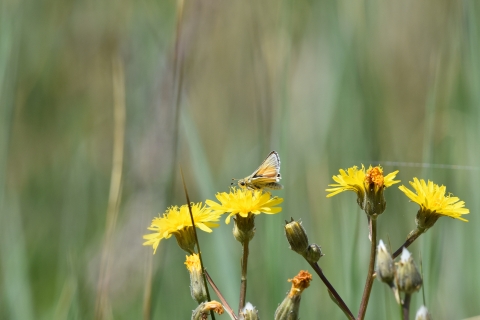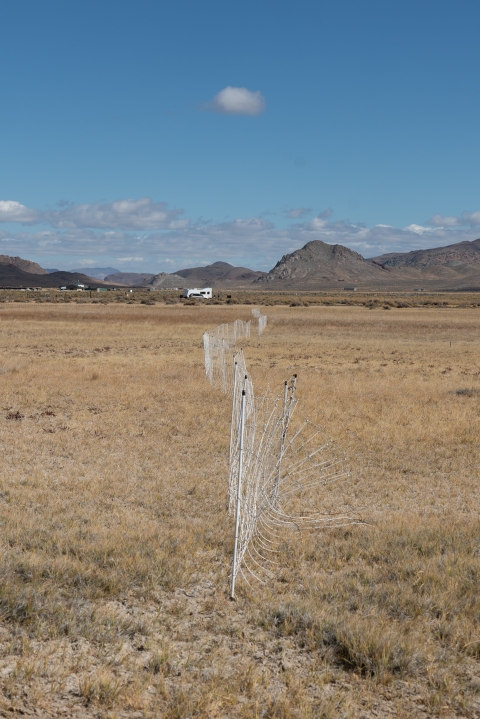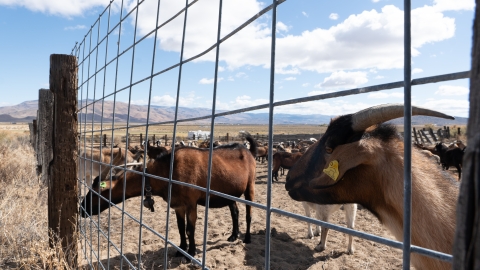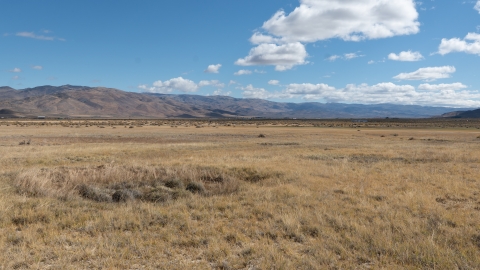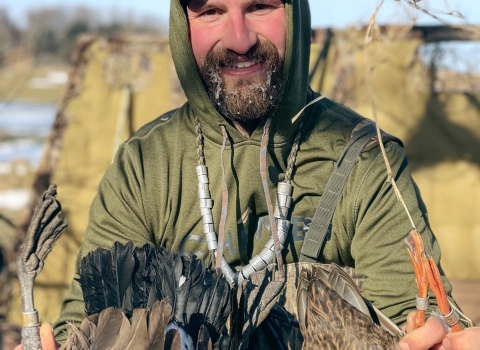A weathered corral appears in the middle of sagebrush sagebrush
The western United States’ sagebrush country encompasses over 175 million acres of public and private lands. The sagebrush landscape provides many benefits to our rural economies and communities, and it serves as crucial habitat for a diversity of wildlife, including the iconic greater sage-grouse and over 350 other species.
Learn more about sagebrush . A small trailer sits behind the wooden fence posts. Inside the corral is a herd of goats. They spring up from their rest as U.S. Fish and Wildlife Service Wildlife Biologist, Lara Enders, enters the corral with Dennie Cook, owner of High Desert Graziers and owner of the goats. “These goats are going to help Carson wandering skipper,” says Enders. “We are using them for targeted grazing to restore the butterfly’s habitat.” The targeted grazing project is part of a collaborative effort between the Service’s Reno field office, and the Bureau of Land Management’s Sierra Front Field Office. This is an experimental effort to improve habitat for an endangered butterfly, the Carson wandering skipper, and to Enders’ knowledge this is the first project that used targeted grazing to benefit an endangered species in Nevada.
Carson wandering skipper is an orange butterfly that calls northern Nevada and a portion of eastern California home. There are only three known populations; the northern-most is found near Honey Lake in California, the southern-most population is found near the Carson River, and the third population lies north of Reno, Nevada. It is this third population where the Service and BLM are experimenting with targeted grazing to restore Carson wandering skipper habitat. The goal is to reduce overgrown vegetation on a BLM Area of Critical Environmental Concern.
Daniella Dekelaita, a wildlife biologist for the BLM, notes that, “The biomass build up [on this site] may be a factor working against Carson wandering skipper.” Biomass refers to the total quantity of organic material that comes from plants or animals in a given area. Dekelaita continued stating that, “the overgrowth in vegetation appears to be crowding out nectar plants, which could make it difficult for Carson wandering skippers to find food.” But why use targeted grazing instead of other management tools?
“Prescribed fire is a tool that would certainly remove biomass, but we had concerns that fire could kill overwintering pupae that are found at the base of saltgrass and may also remove too much of the plant resources that we want to keep,” states Enders. “Mowing is another tool, but it would leave a lot of cut biomass that we would still need to remove from the site. These factors naturally led us to a targeted grazing approach, which allows us to remove some, but not all, standing biomass. This method doesn’t leave as much biomass behind and is less detrimental to overwintering pupae.”
To do the grazing on the landscape, the goat graziers set up a mobile electric fence in different parts of the habitat. They ‘rope’ off an area with the fence, and then herd the goats to the area biologists determined best to graze. The goats are then monitored to ensure the vegetation is grazed down to an agreed upon height. A height that was determined to best allow Carson wandering skippers more space to fly and access the resources they need – flowering plants for nectar, and saltgrass on which they lay their eggs. Once one pasture is grazed to the appropriate height, the goats are moved to another pasture. They are brought back to the corral for rest and water and repeat this process several times throughout the day. “I don’t know of other projects that use targeted grazing for an endangered species. So, to find that this was the best option for our needs, I think is cool and unique.” said Enders.
An interesting benefit that comes from using goats for targeted grazing is that they have very acidic stomachs. This kills the seeds of the vegetation they eat and limits the recruitment of invasive, plants. So, as the goats eat the plants that biologists want out of the area, they also don't need to be concerned that the invasive plants might be reseeded. This is especially helpful for a few key areas that had stands of tall white top, a noxious weed, that is invading portions of the habitat. “Through this management effort, we wouldn’t want to spread those seeds, so knowing the seeds do not survive the digestive track helped us know that this was a good management tool for us,” say Enders.
Another benefit to the project is the overall health of the land. Because Carson wandering skipper is a narrow ranging endemic species (meaning it only exists in a very limited area), it is considered a habitat specialist; it thrives in very specific habitat conditions. While the project is in a small area, this effort will help restore a portion of the larger landscape to a more natural state, improving conditions for other local wildlife.
Enders walks around the site, observing the habitat and the grazing that has taken place. “You can see the difference between the two sides of the fence here,” Enders points out. There is a noticeable difference in the level of vegetation between the grazed and ungrazed sides. How this will impact the butterfly’s population is yet to be known. Fall of 2023 was the first round of implementation for this targeted grazing project. Although more time is needed to track the effectiveness of the targeted grazing, this project is one step in addressing a problem that has been noted by Service and BLM biologists.
When asked why the recovery is important, Enders replied, ““Each species and its habitat play a role in this world. Recovery is important to support and maintain the functional role of this butterfly and its habitat in the larger ecosystem. There is also an inherent value to these species and these areas. Recovery helps maintain the natural beauty of our landscapes which is greater when they are healthy and resilient. Additionally, our agency's mission is the conservation of these species, and that’s what we’re going to do. We are always looking for the best management tools to help to these ends, and it’s an added benefit when that tool is cute, like these goats here!”
To learn more about the species the Reno office works on, visit our It's Out Here page by clicking here.
To watch a video and learn more about Carson wandering skipper, visit this link.
To bring Carson wandering skipper home with you, download an educational flyer here.


